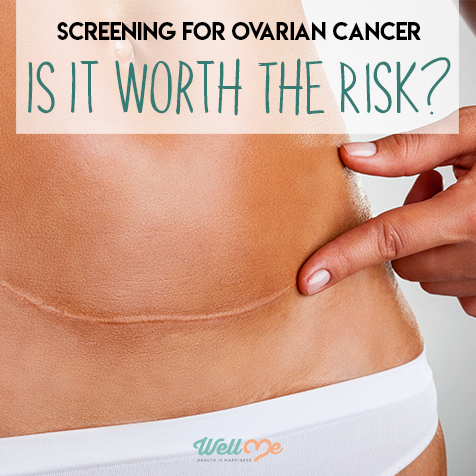Do you worry about the potential risk of ovarian cancer? If you’re like so many women, this has become a very real health scare. Though you may very well take good care of yourself, the potential for developing this type of cancer is present. Many women focus their attention on breast cancer, and for good reason. It is only recently, though, that there has been a shift of focus onto ovarian cancer, a type of cancer that warrants just as much attention, if not more in some instances.
The problem with ovarian cancer is that it often presents itself without any real symptoms. If there are symptoms involved, then it is often later on when the outcome may be dire. This brings about the question of performing screenings for ovarian cancer. At first glance it may seem like the only logical thing to do. If it can help to save lives or expose a potential cancer, then why not do it? Though it does have some benefits, it can also have some drawbacks too.
It May Not Necessarily Save Lives
What you have to keep in mind with an ovarian cancer screening is that it has limited results. Yes it can pick up on this type of cancer, but if it does it may be too late. This is perhaps one of the most important things to look at because the end result with a screening is to help save lives.
When a recent study was performed[1] it was found that even for those women who were screened, it didn’t necessarily have a tie to decreased mortality. It may be the function of the screening test itself or it may be that the results come too late in the process. It may also be that this type of cancer is hard to find through a screening process. Therefore, just because the screening test is done, it doesn’t necessarily translate to a significant number of lives saved.
Some may say that such screenings are not necessarily a bad thing and what can it hurt anyhow? Sure, the actual test may not cause any harm, but it’s what it can lead to. It’s what may be the next steps such as unnecessary additional diagnostic tests that can introduce unnecessary risks.
Not only that but even if ovarian cancer is detected, this study shows that it may not result in lives saved. If that’s the entire purpose of a screening test, then it may be destined for failure from the start. Though it is worth understanding why the test has limits and why it doesn’t always work, just to be certain that all risks and benefits are considered.
You Must Consider Your Risk Level

This is one of the most important considerations in the ovarian cancer screening test. Though you might think that all screening tests work the same, that’s not necessarily the case. In this instance, you have to consider the risk of the individual woman to determine if the risk is worth it. Is there a family history of ovarian cancer? Are there other types of cancer in the family? Has the woman had any previous related health issues? Has the woman had any symptoms to indicate ovarian cancer? Is there any reason to believe that cancer is even a possibility?
Before a doctor performs this screening test, you want to be sure that you weigh your personal risks. If you have no potential risk factors, then the rest is unnecessary. If you have no family history or symptoms or reason to believe that ovarian cancer may be present, then the rest is simply not worth it. That’s what makes this a very individual process and test in general, for you must look at each situation and make decisions based off of that.
Though everyone wishes for or wants a “one size fits all” type of screening test to stop ovarian cancer, we may not be there yet. As this study indicates, if the woman has a marginal or even average risk of ovarian cancer, then the test serves no purpose. It’s always important to keep an eye on your health overall, but beyond that this screening test may be unnecessary. It may also lead to bigger problems as you will see—and therefore it is a case where no test is better than going down this path.
There’s Potential for a False Positive
Herein lies the problem with this particular test, though it is not an uncommon problem associated with screening tests overall. With this screening test for ovarian cancer, there is a very real possibility of false positive results. It’s the way that the test is done, the way that it measures things overall, and the reading of the test that contribute to this possibility. Obviously, if a test is supposed to help you with diagnosis and further steps in the process, this works against things and creates a bigger headache in the end.
In the aforementioned study there was a significant number of women who had the screening test done and then false positives were found. This indicated that there may be an issue with the test or that something was triggered in the results. It’s important to keep in mind that this is a comprehensive test and therefore any possible variance, big or small, can indicate that something is amiss. That’s not a bad thing in theory, but in practice it leads women down a bad and often unnecessary path. Hearing that there is a positive result for potential ovarian cancer is bad physically, mentally, and emotionally!
If the results indicate a potential positive, there is more to this than just the emotional stress on the woman affected. This also means that there are going to be next steps in the process. It means that further testing is going to be needed. The woman is suffering all the while; she may not even have cancer at all. False positives are a very real possibility with many diagnostic tests, but the possibility and likelihood of them with this particular test is quite significant.
It Could Lead To Unnecessary Surgery or Further Diagnostic Tests

As if it’s not bad enough that the test can be inconclusive, the risk for false positives is very hard to live with. If it is found that the test results are positive, the woman must go further along in the process to see what is going on. This isn’t unusual and follows the path for any type of cancer or health condition in general. It doesn’t just stop with the first screening test — that is often the gateway to many other tests and ways of detecting what is going on.
So, if a woman receives positive results for potential cancer on the first test, then the process continues onto further screenings, some of which can be very invasive in nature. This may all be for nothing in the long run if the result was a false positive. The results of these invasive tests could lead to even more unnecessary tests so that a woman who may not even have ovarian cancer at all has to go through a whole series of poking, prodding, testing, and invasive measures that aren’t even necessary.
The false positive may even lead to surgery to rule out or try to “treat” the problem indicated by the screening. When there is nothing going on at all, this makes for a really unnecessary and uncomfortable situation. Though the surgery can be a very positive thing if ovarian cancer is in fact present, that’s not always the case. Some women may have the surgery performed and find that there was nothing wrong in the first place. This is the risk of a false positive, and this is also why this test has very real limitations and mixed results. You must know that these are possibilities and potential risks, and that they are very common with this screening process. All of this may be for nothing at all!
The Risks Outweigh Any Potential Benefits
This is ultimately what it boils down to and it is something you must ask yourself when you consider any type of test or medical treatment in the first place. You even see this sort of information included on medication that you may take. If you are doing something to try and help yourself or work through a possible medical issue, then you have to look at it holistically. You have to consider this as a whole so that you can make an important decision about next steps.

Are the benefits worth the potential risks? Are you going to do more harm than good? Is it better to leave the problem alone or to go through other methods of diagnosis or treatment? This is what you have to consider when it comes to the ovarian cancer screening test and the unwavering answer is usually no, the benefits aren’t worth the potential risks. Therefore you must really ask yourself why you’re doing this in the first place. If you are causing more harm than potential good, then what really is the point?
The general consensus in this study and from many within the medical community, is that the ovarian cancer screening test is simply not worth the potential risks involved. Yes, it can do more harm than good! When you look at it that way, then you can make a very clear decision and protect your health in other ways. Always consider the risks and if it paints this type of picture, then it’s very clear as to what you should and should not do here. Trust that this study is rather extensive and the results are very clear and straightforward in nature.
Fun Fact: Women who have never had children, who have unexplained infertility, or who had their first child after age 30 may be at increased risk for this cancer. Women who have used estrogen alone as hormone replacement therapy are also at increased risk. Women with a personal or family history of hereditary non-polyposis colon cancer (HNPCC), ovarian cancer, or breast cancer are more likely to have this disease.[2]
Summary: What Should You Do Now?
When you consider any sort of screening test, you must look at the big picture. You have to consider what the results may mean and what you would do next. You must also look at things such as your risk factor to paint the entire picture. If you do not have any potential risk factors, a family history, or symptoms of ovarian cancer, then a screening test may very well be unnecessary.
If it is in fact going to do more harm than good, then it’s simply not worth it. Though preventative care is always important, it often does not tell the whole story such as in this case. Be vigilant, be your own best advocate, get tests done when necessary, and know when the risks of something far outweigh the benefits such as in this instance.

Action Steps: Tips for Deciding If This Test Is Right For You
- Assess your potential risk factors for ovarian cancer.
- Talk to your doctor about your concerns or to determine if you are a candidate for this screening.
- Make the decision if the screening test is right for you.
- If you do get the screening then know the risks and potential for false positives.
- Always take care of your health and be proactive first and foremost.
Though it may seem as if a screening test for ovarian cancer is a no-brainer, that’s not necessarily the case. As with any diagnostic test, there are potential drawbacks to it. Though it may seem like a viable way to test for this type of cancer, it may be an unnecessary step in the process. Consider your individual situation and then make the decision that is right for you. It’s always best to talk to your doctor and to be your own best advocate.
Preventative care is an important part of your overall health, but you must always consider the risks as well as the benefits. In this case, the risks for this screening test may not warrant having it done. Be sure that you are informed, that you know what may be at stake, and that you move forward with next steps accordingly. This is how to approach this screening test and other diagnostic measures as well.
References
- [1] Don’t Screen Average Risk Women For Ovarian Cancer AAFP https://www.aafp.org/news/health-of-the-public/20170725uspstf-ovarian.html
- [2] Cancer Facts For Women American Cancer Society https://www.cancer.org/healthy/find-cancer-early/womens-health/cancer-facts-for-women.html








